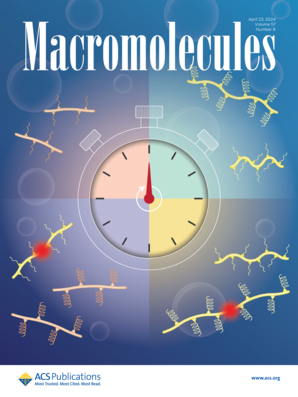Anisotropic Mixed Conduction of Electrons and Ions in Liquid Crystalline Supramolecular Complexes of Polythiophene and Imidazolium-Based Ionic Liquids
IF 5.1
1区 化学
Q1 POLYMER SCIENCE
引用次数: 0
Abstract
Mixed ionic-electronic conducting polymers (MIECPs) show promise for next-generation electrochemical devices due to the unique ability to simultaneously conduct both ions and electrons. However, there is a trade-off between electronic and ionic conduction because of their opposite morphology dependence. Here, we report simultaneous high electron-conduction and high ion-conduction in thin films of supramolecular MIECPs through the liquid crystalline (LC) assembly pathway from solution to the solid state. The supramolecular MIECPs are prepared via non-covalent bonding between carboxylated poly(3-alkyl thiophene)s and an imidazolium-based ionic liquid (IL) surfactant and characterized by means of UV–visible (UV–vis) absorption spectroscopy, polarized optical microscopy (POM) and small-angle X-ray scattering (SAXS). After complexation, the system displays colorimetric transitions and optoelectronic changes with the IL surfactant mole ratio. At equal stoichiometry, the polymer displays a rodlike conformation with planarization of the conjugated backbone. The hydrogel of the equimolar solution exhibits a typical LC polydomain texture with strong birefringence under POM, which is identified as a smectic LC mesophase with lamellar periodicity using SAXS. Defect-free LC monodomains containing unidirectional alignment are obtained in the hydrogel through mechanical shearing. After complete solvent evaporation, the LC monodomain structures are retained in the solid-state film, resulting in simultaneously high electronic (10-2- 10-1 mS/cm) and ionic (10-3 - 10-2 mS/cm) conductivities at ambient temperature. Generally, the block copolymers of MIECPs show high ionic conductivities (10-2 - 1 mS/cm) but low electronic conductivities (10-5 - 10-2 mS/cm). While the homopolymers of MIECPs display high electronic conductivity (10-6 - 102 mS/cm) but low ionic conductivity (10-6 - 10-2 mS/cm). In addition, aligned solid-state films show a significant anisotropy in both electronic (anisotropic ratio of ∼6) and ionic (anisotropic ratio of ∼117) conductivities, with faster charge transport along the shear direction than the perpendicular direction. It is believed that aligned conjugated backbones along the shear direction provide channels for fast band-like transport of electronic charge carriers and aligned imidazolium moieties in the lamellar layers form constrained channels for ion motion.

聚噻吩和咪唑基离子液体液晶超分子配合物中电子和离子的各向异性混合传导
混合离子-电子导电聚合物(MIECPs)具有同时导电离子和电子的独特能力,有望成为下一代电化学器件。然而,由于它们相反的形态依赖,在电子传导和离子传导之间存在权衡。在这里,我们报道了超分子MIECPs薄膜通过液晶(LC)组装途径从溶液到固体状态同时具有高电子传导和高离子传导。通过羧基聚(3-烷基噻吩)s与咪唑基离子液体(IL)表面活性剂之间的非共价键合成了超分子MIECPs,并通过紫外可见吸收光谱(UV-vis)、偏振光学显微镜(POM)和小角x射线散射(SAXS)对其进行了表征。络合后,随着IL表面活性剂摩尔比的变化,体系呈现出比色跃迁和光电子变化。在相同的化学计量下,聚合物呈棒状构象,共轭主链呈平面化。等摩尔溶液的水凝胶在POM作用下呈现出典型的具有强双折射的LC多畴织构,通过SAXS鉴定为具有层状周期性的半晶LC中间相。通过机械剪切,在水凝胶中获得了含有单向排列的无缺陷LC单畴。溶剂完全蒸发后,LC单畴结构保留在固态膜中,从而在室温下同时具有高电子(10-2- 10-1 mS/cm)和离子(10-3 - 10-2 mS/cm)电导率。通常,MIECPs嵌段共聚物具有高离子电导率(10-2 - 1 mS/cm)和低电子电导率(10-5 - 10-2 mS/cm)。而MIECPs均聚物的电子电导率高(10-6 - 102 mS/cm),离子电导率低(10-6 - 10-2 mS/cm)。此外,排列的固态薄膜在电子(各向异性比为~ 6)和离子(各向异性比为~ 117)电导率上都表现出显著的各向异性,沿剪切方向的电荷输运比垂直方向快。认为沿剪切方向排列的共轭骨架为电子载流子提供了快速带状输运通道,而层状层中排列的咪唑基团为离子运动提供了约束通道。
本文章由计算机程序翻译,如有差异,请以英文原文为准。
求助全文
约1分钟内获得全文
求助全文
来源期刊

Macromolecules
工程技术-高分子科学
CiteScore
9.30
自引率
16.40%
发文量
942
审稿时长
2 months
期刊介绍:
Macromolecules publishes original, fundamental, and impactful research on all aspects of polymer science. Topics of interest include synthesis (e.g., controlled polymerizations, polymerization catalysis, post polymerization modification, new monomer structures and polymer architectures, and polymerization mechanisms/kinetics analysis); phase behavior, thermodynamics, dynamic, and ordering/disordering phenomena (e.g., self-assembly, gelation, crystallization, solution/melt/solid-state characteristics); structure and properties (e.g., mechanical and rheological properties, surface/interfacial characteristics, electronic and transport properties); new state of the art characterization (e.g., spectroscopy, scattering, microscopy, rheology), simulation (e.g., Monte Carlo, molecular dynamics, multi-scale/coarse-grained modeling), and theoretical methods. Renewable/sustainable polymers, polymer networks, responsive polymers, electro-, magneto- and opto-active macromolecules, inorganic polymers, charge-transporting polymers (ion-containing, semiconducting, and conducting), nanostructured polymers, and polymer composites are also of interest. Typical papers published in Macromolecules showcase important and innovative concepts, experimental methods/observations, and theoretical/computational approaches that demonstrate a fundamental advance in the understanding of polymers.
 求助内容:
求助内容: 应助结果提醒方式:
应助结果提醒方式:


